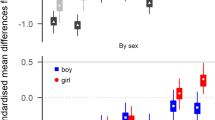Abstract
Two studies investigated differences in qualitative movement features between hyperactive and comparison boys and decrements in these features when the hyperactive boys were medicated in contrast to when they were given placebo. The qualitative features were quick, strong, intense, and unexpected transition. These movement features were rated from videotapes of a board game for 44 hyperactive and 63 comparison boys in the two studies. Each boy played the game twice with a week between occasions, and a medication-placebo crossover design was in effect within the hyperactive group. Relationships were also assessed between a standard measure of hyperactivity, the Conners Abbreviated Symptom Questionnaire, and the qualitative features. Hyperactive children showed a greater incidence of strength, intensity, and unexpected transitions, and there was a consistent medication decrement in unexpected transitions. Finally, there were moderate correlations between ratings on the hyperactivity scale and each of the qualitative features.
Similar content being viewed by others
References
Abikoff, H., Gittelman, R., & Klein, D.F. (1980). Classroom observation code for hyperactive children: A replication of validity.Journal of Consulting and Clinical Psychology, 48 555–565.
American Psychiatric Association. (1987).Diagnostic and statistical manual of mental disorders (3rd ed., revised). Washington, DC.
Barkley, R.A. & Cunningham, C.E. (1979). Stimulant drugs and activity level in hyperactive children.American Journal of Orthopsychiatry, 49 491–499.
Barkley, R.A. & Ullman, D.G. (1975). A comparison of objective measures of activity and distractibility in hyperactive and nonhyperactive children.Journal of Abnormal Child Psychology, 3 231–244.
Blunden, D., Spring, C., & Greenberg, L.M. (1974). Validation of the classroom behavior inventory.Journal of Consulting and Clinical Psychology, 42 84–88.
Goyette, C.H., Conners, C.K., & Ulrich, R.F. (1978). Normative data on revised Conners Parent and Teacher Rating Scales.Journal of Abnormal Child Psychology, 6 221–236.
Henker, B., Astor-Dubin, L. & Varni, J. (1986). Psychostimulant medication and perceived intensity in hyperactive children.Journal of Abnormal Child Psychology, 14 105–114.
Laban, R., & Lawrence, F.C. (1974).Effort: Economy in body movement. Boston: Plays, Inc.
Mintz, L.I. (1985).Determinants of consensus in clinical ratings of hyperactive and normal children. Unpublished doctoral dissertation. University of California, Los Angeles.
Porrino, L.J., Rapoport, J.L., Behar, D., Sceery, W., Ismond, D.R., & Bunney, W.E. (1983). A naturalistic assessment of the motor activity of hyperactive boys: I. comparison with normal controls.Archives of General Psychiatry, 40 681–687.
Whalen, C.K. (1989). Hyperactivity, learning problems, and the attention deficit disorders. In T.H. Ollendick & M. Hersen (Eds.)Handbook of Child Psychopathology. New York: Plenum Press.
Whalen, C.K., Collins, B.E., Henker, B. Alkus, S.R., Adams, D., & Stapp, J. (1978). Behavior observations of hyperactive children and methylphenidate (Ritalin) effects in systematically structured classroom environments: Now you seen them, now you don't.Journal of Pediatric Psychology, 3 177–187.
Whalen, C.K., & Henker, B. (1976). Psychostimulants and Children: A review and analysis.Psychological Bulletin, 83 1113–1130.
Whalen, C.K., Henker, B., Collins, B.E., Finck, D., & Dotemoto, S. (1979a). A social ecology of hyperactive boys: Medication effects in structured classroom environments.Journal of Applied Behavior Analysis, 12 65–81.
Whalen, C.K., Henker, B., Collins, B.E., McAuliffe, S. & Vaux, A. (1979b) Peer interaction in a structured communication task: Comparisons of normal and hyperactive boys and of methylphenidate (Ritalin) and placebo effects.Child Development, 50 388–401.
Whalen, C.K., Henker, B., Dotemoto, S., Vaux, A., & McAuliffe, S. (1981). Hyperactivity and methylphenidate: Peer communication patterns. In K.D. Gadow & J. Loney (Eds.)Psychosocial aspects of drug treatment for hyperactivity. Boulder, CO: Westview Press.
Whalen, C.K., Henker, B., Buhrmester, D., Hinshaw, S.P., Huber, A., & Laski, K. (1989). Does stimulant medication improve the peer status of hyperactive children?Journal of Consulting and Clinical Psychology, 57 545–54.
Additional information
These studies were conducted at the Fernald Child Study Center at UCLA. The author would like to thank Barbara Henker for consultation and generous assistance at every step of the way and Carol K. Whalen for creating the experimental game on which these studies were based. Thanks are also due to Barbara Henker, Carol K. Whalen, and Barry Collins for organizing the summer research programs, and to the conscientious staff and students who provided the ratings. Correspondence concerning this article and requests for reprints should be addressed to Linda S. Goodman, Dance Department, University of California, Los Angeles, CA 90024.
Rights and permissions
About this article
Cite this article
Goodman, L.S. Movement behavior of hyperactive children: A qualitative analysis. Am J Dance Ther 13, 19–31 (1991). https://doi.org/10.1007/BF00843874
Issue Date:
DOI: https://doi.org/10.1007/BF00843874




